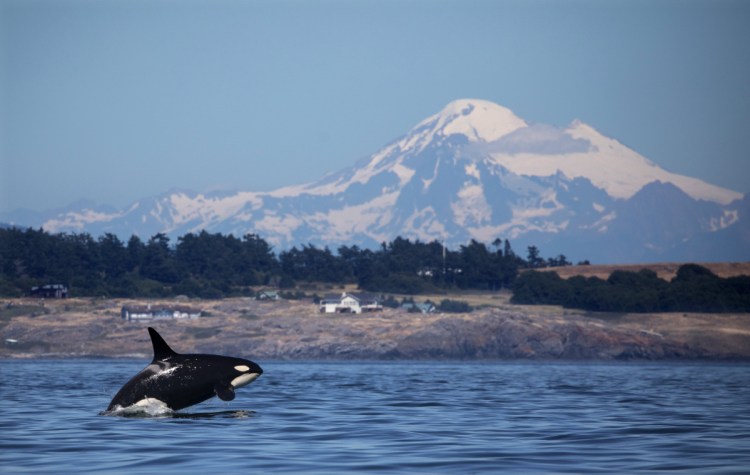BLACKFISH SOUND, QUEEN CHARLOTTE STRAIT, B.C. — Bigger and bigger, with a puff and a blow, the orca surfaces, supreme in his kingdom of green.
Northern resident orcas like this one live primarily in the cleaner, quieter waters of northern Vancouver Island and Southeast Alaska, where there also are more fish to eat. They are the same animal as the southern residents that frequent Puget Sound, eating the same diet, and even sharing some of the same waters. They have similar family bonds and culture.
The difference between them is us.
The southern residents are struggling to survive amid waters influenced by more than 6 million people, between Vancouver and Seattle, with pollution, habitat degradation and fishery declines. The plight of the southern residents has become grimly familiar as they slide toward extinction, with three more deaths just last summer. Telling was the sad journey of J35, or Tahlequah, traveling more than 1,000 miles for at least 17 days, clinging to her dead calf, which lived only one half-hour.
ANOTHER WORLD
Yet just to the north, the orca population has more than doubled to 309 whales since scientists started counting them in 1974, and has been growing ever since, at 2.2 percent per year on average.
For scientists seeking to better understand the southern residents’ troubles, the northern residents are like a control group, said Sheila Thornton, chief killer-whale biologist for the Department of Fisheries and Oceans Canada.
“Their environment has changed so quickly, over just two generations,” Thornton said of the southern residents. “To keep up with these changes is almost an impossible task. How do they survive in the environment we have created for them?”
The decline of the whales, a symbol of the Northwest, is also a warning, as climate change and development remake the region.
The northern residents live in not just a different place, but another world.
NO SANCTUARY
The northern residents generally keep to northern Vancouver Island and Southeast Alaska, while the southern residents ply the trans-boundary waters of the Salish Sea between the U.S. and Canada and outer coast of Washington, Oregon and even California. The transients travel both places and the offshores typically keep to the outer continental shelf. The three types don’t interbreed, don’t share language, food or culture, and are not known to fight.
The southern residents have no such respite or sanctuary from human intrusion and noise. While they are the most studied whales in the world, and among the most endangered orcas, they contend with boat traffic and human intrusion even in their most critical foraging areas, such as the west side of San Juan Island.
The northern residents’ sanctuary, set aside for feeding, socializing and enjoying the rubbing beaches, isn’t perfect. Commercial fishermen are allowed into the sanctuary to pursue sockeye. And adjoining Johnstone Strait remains a major connecting waterway between the waters of Southeast Alaska and the Salish Sea.
Sure enough: A cruise ship suddenly comes into view, five stories high, blocking sight of the glittering waters of the strait. It seems spectacularly out of place, an emissary from the lands and waters to the south — where, amid millions of people, the southern residents try to live and cope.
It was these hostile waters through which Tahlequah swam, carrying her sad burden day after day. She swam south of Vancouver, past the coal docks piled high and ghosting black dust into the water. She swam through busy shipping lanes in Haro Strait, amid oceangoing container ships and oil tankers towering over her. She swam through busy boat traffic, including commercial whale-watch boats that make millions of dollars every season. Vessel noise masks the sounds the orcas use to find their food, adding to their troubles.
She and her family contend with other threats to their survival too: toxics that seep into the food chain, then into whale mothers’ milk. A recent study predicted a global killer-whale population collapse because of polychlorinated biphenyls, or PCBs, in the orcas’ food chain. A group of toxic, man-made chemicals, PCBs were banned from manufacture in the U.S. in 1979, but are still ubiquitous in the environment.
PCBs were used around the world for decades, primarily to insulate and cool electrical equipment and prevent electrical fires. They were also used in hydraulic systems, lighting and cable insulation, paint, caulking, sealants, inks and lubricants. Today PCBs still leach, leak, dissipate into the atmosphere and contaminate runoff during rainfall.
Southern residents are at more grave risk of health effects from PCBs and other toxics than the northern orcas, the study found, because the southern residents live in more polluted waters.
Toxics also are more dangerous for them because they don’t have enough to eat. When they go hungry, orcas burn their fat, releasing toxics into their bloodstream.
To be sure, the northern residents are still a threatened species, and have troubles of their own. But the southern residents always have had the short end of the stick, said Jared Towers, a killer-whale expert with Fisheries and Oceans Canada who has studied both populations.
Send questions/comments to the editors.



Comments are no longer available on this story